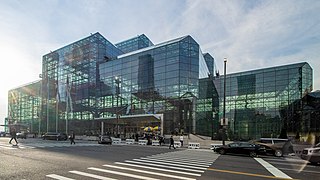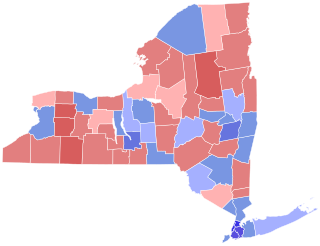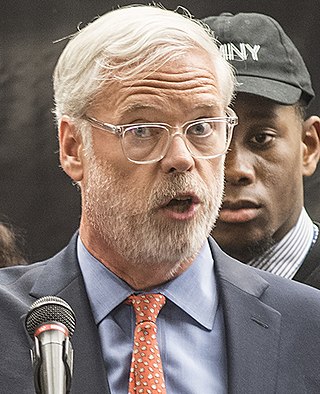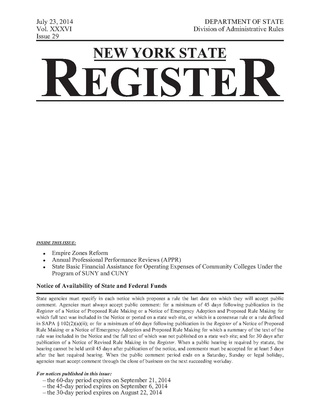
Richard Ravitch was an American politician and businessman who served as the lieutenant governor of New York from 2009 to 2010. He was appointed to the position in July 2009 by New York Governor David Paterson. A native of New York City, he graduated from Yale Law School and he worked in his family's real estate development business, a number of government and government-appointed positions, including with the New York State Urban Development Corporation and Metropolitan Transportation Authority, and in private industry, including tenures as chairman of the Bowery Savings Bank and as the chief owner representative in labor negotiations for Major League Baseball.

Long Island Power Authority is a municipal subdivision of the State of New York that owns the electric transmission and electric distribution system serving all of Long Island and a portion of New York City known as the Rockaways. LIPA was originally created under the Long Island Power Act of 1985 to acquire the Long Island Lighting Company (LILCO)'s electric and natural gas infrastructure after the cancellation of the Shoreham Nuclear Power Plant. LIPA acquired LILCO's transmission system in May 1998, while the remainder of LILCO's natural gas-related infrastructure merged with Brooklyn Union Gas to form KeySpan Energy.

Pacific Park is a mixed-use commercial and residential development project by Forest City Ratner that will consist of 17 high-rise buildings, under construction in Prospect Heights, adjacent to Downtown Brooklyn, Park Slope, and Fort Greene in Brooklyn, New York City. The project overlaps part of the Atlantic Terminal Urban Renewal Area, but also extends toward the adjacent brownstone neighborhood. Of the 22-acre (8.9 ha) project, 8.4 acres (3.4 ha) is located over a Long Island Rail Road train yard. A major component of the project is the Barclays Center sports arena, which opened on September 21, 2012. Formerly named Atlantic Yards, the project was renamed by the developer in August 2014 as part of a rebranding.

The Jacob K. Javits Convention Center, commonly known as the Javits Center, is a large convention center on Eleventh Avenue between 34th Street and 38th Street in Hell's Kitchen, Manhattan, New York City. It was designed by architect James Ingo Freed of Pei Cobb Freed & Partners. The space frame structure was constructed from 1979 to 1986 and was named to honor Jacob Javits, the United States Senator for New York. When the Javits Center opened, it replaced the New York Coliseum at Columbus Circle as the city's major convention facility; the Coliseum was subsequently demolished and replaced by Time Warner Center.
New York state public-benefit corporations and authorities operate like quasi-private corporations, with boards of directors appointed by elected officials, overseeing both publicly operated and privately operated systems. Public-benefit nonprofit corporations share characteristics with government agencies, but they are exempt from many state and local regulations. Of particular importance, they can issue their own debt, allowing them to bypass limits on state debt contained in the New York State Constitution. This allows public authorities to make potentially risky capital and infrastructure investments without directly putting the credit of New York State or its municipalities on the line. As a result, public authorities have become widely used for financing public works, and they are now responsible for more than 90% of the state's debt.
The Roosevelt Island Operating Corporation (RIOC) is a New York State public-benefit corporation responsible for developing Roosevelt Island, a small island in the East River that is part of the New York City borough of Manhattan.

The 2002 New York gubernatorial election was held on November 5, 2002. Republican Governor George Pataki was re-elected to a third term, defeating Democrat Carl McCall and Rochester billionaire Tom Golisano, who ran on the Independence Party line. As of 2024, this was the last time a Republican won a statewide election in New York, and the last time Albany, Tompkins and Westchester counties have voted Republican in a statewide election.
Leecia Roberta Eve is an American attorney from New York with experience in federal government, state government, and the private sector who currently works as a lobbyist for telecommunications giant Verizon. Born in Buffalo, Eve was a candidate for Lieutenant Governor of New York during the 2006 election. After working for U.S. Sen. Hillary Clinton, Eve served as a senior advisor during Clinton's 2008 presidential campaign. From 2011 to 2013, she was Deputy Secretary for Economic Development in the Executive Chamber of New York Governor Andrew M. Cuomo. She was appointed to the Board of Commissioners of the Port Authority of New York and New Jersey in July 2017. Eve ran for Attorney General of New York in 2018, but was defeated in the Democratic primary.

The 2006 New York Attorney General election took place on November 7, 2006. Democrat Andrew Cuomo was elected to replace Eliot Spitzer as the Attorney General of New York.

The Dormitory Authority of the State of New York provides construction, financing, and allied services which serve the public good of New York State. More specifically, as a New York State public-benefit corporation, DASNY provides services for public and non-proprietary private universities in New York State; for not-for-profit healthcare facilities in the State; and for other New York State-related institutions/purposes. Like other public authorities in New York, DASNY has the flexibility to borrow on behalf of the state through legislative authorization, rather than incurring general obligation debt, which requires voter approval.
The New York State Housing Finance Agency (HFA) is a New York State public-benefit corporation created in 1960 to build and preserve affordable multifamily rental housing throughout New York State. HFA sells bonds and uses the proceeds to make mortgages to affordable housing developers.
The State of New York Mortgage Agency is a New York State public-benefit corporation created in 1970 by the state government of New York to provide affordable homeownership to low- and moderate-income New Yorkers. It offers affordably priced fixed-rate mortgages through several mortgage programs for eligible homebuyers. Each program offers competitive interest rates, low down payments, down payment assistance and no prepayment penalties. SONYMA offers its programs through a network of participating lenders throughout New York state who contract with the agency to offer SONYMA's programs to their customers. The mortgage loans are purchased from the lenders by SONYMA, which funds the purchases by issuing tax-exempt bonds. In 2017, it had operating expenses of $62.57 million, an outstanding debt of $2.533 billion, and a staff level of 275 people.

New York held various elections on November 7, 2006. Most notably, elections were held for the state governor, attorney general, comptroller, and for the U.S. Senate, all of which saw Democrats win and build on their existing majority. While Democrats had already been a strong force in the New York City area, most of the Democratic gains in 2006 occurred upstate. Former Attorney General Eliot Spitzer won the 2006 gubernatorial election by a record margin, while Andrew Cuomo replaced him as the new attorney general. Alan Hevesi was re-elected as comptroller, despite mounting ethics concerns. Hillary Clinton was re-elected to the Senate. For the first time in over 50 years, all major statewide elected offices were held by one party. For the first time in over 60 years, they were all held by Democrats.
The New Jersey Office of the State Comptroller(OSC) is an independent agency of the Government of New Jersey created by an act of the state legislature in 2007 in order to make government more efficient, accountable and transparent. The State Comptroller is appointed by the Governor of New Jersey, with the advice and consent of the New Jersey Senate, to a renewable six-year term.

Patrick Joseph Foye is an American lawyer who served as Chairman and CEO of the New York Metropolitan Transportation Authority (MTA). Prior to this role, he served as President of the MTA and Executive Director of the Port Authority of New York and New Jersey.

The New York State Register is the official journal of the New York state government that contains information on proposed regulations and rulemaking activities. The New York State Register is published weekly by the New York State Department of State's Division of Administrative Rules. The general and permanent regulations are compiled in the New York Codes, Rules and Regulations (NYCRR).
Buffalo Billion is a New York state government project led by former Governor Andrew Cuomo that aims to invest $1 billion in the Buffalo, New York area economy. The project uses a combination of state grants and tax breaks to spur economic development. Governor Cuomo first announced the program in his 2012 "State of the State" address. The program is modeled on a similar program implemented in the Albany, New York area. A key project in the program is a $750 million SolarCity solar panel factory.

Queens West is a district and redevelopment project along the East River in Long Island City, Queens, New York City. The project, located on Hunter's Point south of the Anable Basin, is a joint project sponsored by the Port Authority of New York & New Jersey (PANYNJ) and the Empire State Development Corporation (ESD). The Queens West Development Corporation (QWDC), a subsidiary of ESD, was established in 1992 to facilitate implementation of the approved development plan.
The New York Local Government Assistance Corporation is a New York state public-benefit corporation created in 1990 to issue bonds to decrease the state's reliance on short term loans.
The Tobacco Settlement Financing Corporation is a New York State public-benefit corporation that is administered by New York State Homes and Community Renewal. It used to be a subsidiary to the State of New York Municipal Bond Bank Agency. The Tobacco Settlement Financing Corporation was created as a separate legal subsidiary of the New York State Municipal Bond Bank Agency to securitize a portion of the State's future revenues from its share of the 1998 Master Settlement with the participating cigarette manufacturers in order to make a $4.2 billion payment to State's General Fund. During calendar year 2003, the Tobacco Settlement Financing Corporation issued bonds and remitted the $4.2 billion payment to the State. In 2017, it had operating expenses of $2.94 million, no outstanding debt, and a staffing level of 267 people.












